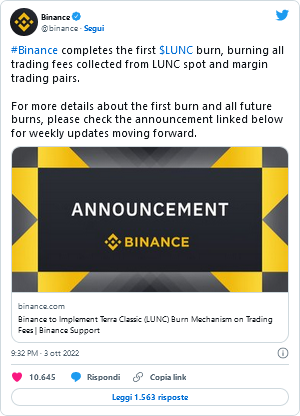Yesterday Binance announced its first LUNC ( Luna Classic ) burn.
Luna Classic: Binance burns tokens
The exchange has in fact destroyed all the LUNC tokens collected with trading fees.
Luna Classic is the new name that was given to the cryptocurrency Luna after the implosion of the Terra ecosystem (renamed Terra Classic), and the birth of the new cryptocurrency LUNA.
Before the collapse, the value of the LUNCs, when they were still called Luna, was around $ 86, but within a week just before mid-May their value had almost zeroed, even falling below $ 0.01.
This real rapid implosion was also due to an incredible explosion in the number of tokens in circulation.
In fact, Luna's supply was not fixed, and it varied in an algorithmic way to try to keep the value of the UST stablecoin fixed. When the UST implosion began, the system went haywire, and a huge amount of Luna tokens were produced. It went from about 345 million Luna to over six trillion in the space of a week.
This boom literally destroyed the market value of the tokens, effectively imploding the entire Earth ecosystem.
However, starting in late May the old Terra team abandoned the old ecosystem, and created a new one with the same name. The old ecosystem was renamed Terra Classic, the old cryptocurrency was renamed Luna Classic (LUNC), and a new team took over its management.
One of the initiatives taken was precisely the attempt to reduce the immense supply by starting to burn the tokens.
Currently of the more than 6.9 trillion LUNCs in existence, there are “only” just over 6.890 billion in circulation, thanks to the burn process.
These also include the over 5 billion LUNCs just burned by Binance.
Although 5 billion may seem like a large number in words, it is only less than 0.08% of the LUNC tokens in circulation, so in itself the impact of this burn on the supply of cryptocurrencies is irrelevant.
Furthermore, up to now, 0.14% of the total LUNC tokens have been burned overall, therefore a small percentage. However, it must be borne in mind that not all LUNCs in circulation are on the market. In fact, many of these are in fact frozen, so the real impact of burns on tokens in circulation on the market is greater.
This yesterday generated a 20% increase in the value of LUNC on the market, although much of this gain has vanished today.
Luna Classic the token for speculation
LUNC currently remains a cryptocurrency dominated by speculative trading, which amplifies the impact of news both up and down. This explains both why such a low percentage burn could generate an increase in market value of as much as 20%, and why this gain was almost completely lost in the hours following the peak.
It should be noted, however, that the minimum peak of the last few months was reached last week, or on September 26, and since then the price of LUNC has increased by 73%. This figure clearly shows how speculative this cryptocurrency is still right now.
In addition, it should be emphasized that compared to the absolute minimum of mid-May, growth at the current stage has already been 31,800%, despite this has not made it possible to approach the pre-collapse levels in the least. In fact, compared to the value of the Moon at the beginning of May, the current loss continues to be above 99.99%.
It must be said that Binance has been involved in the Earth project since practically its origins, so despite everything that has happened it continues to make its contribution, for example by burning the LUNCs collected with commissions on exchanges.
While it currently seems unlikely that LUNC's supply will shrink drastically with these burns, the fact that they are continuing and that much of the supply is effectively immobilized suggests that perhaps its market value may grow somewhat in the future. .
For sure it is almost impossible that it will ever recover pre-crash levels, but it also seems extremely unlikely that it will return to $ 1. Indeed, it currently seems decidedly unlikely that it will even return above one cent.
Much will depend on the management of the new team, and above all on the fact that they are able to give new impetus to a project that actually failed in May. It should not be forgotten that it could suffer from competition from the new Terra project, and therefore also from the new LUNA cryptocurrency, although the algorithmic stablecoin that was the basis of the previous one is absent in the new ecosystem.
Meanwhile, Binance is expanding, with the opening of two new offices in Brazil.
Latin America appears to be fertile ground for cryptocurrencies, as demonstrated by the case of El Salvador, and Brazil is the largest country in the whole area, as well as being a country where interest in cryptocurrencies is particularly widespread. .
Now more and more countries require exchanges to open physical offices in order to operate within them, so it is more than logical that exchanges open offices especially in those countries where they have more customers.
In Brazil, Binance has chosen to open offices in the two main cities, Sao Paulo and Rio de Janeiro, where it has over 150 employees. The company says that most of these employees will work on customer service and support, and that Brazil is among the top 10 markets in the world for the exchange.
The company recently bought local broker Sim; paul, in order to also acquire the license as a regulated payment institution, although this operation is still under consideration by the central bank. If approved, Binance in Brazil could operate with a specific government license.
In order to ensure legal development in the country, Binance also recently announced the hiring of former president of the Brazilian central bank, and former finance minister, Henrique Meirelles, on the advisory board of the company.




EmoticonEmoticon